'Azur: Sintra's stained glass' which reads the opponent's strategy side by side with stained glass like gems is more than the previous work and completeness and beauty

" Azur: Sintra's stained glass " which is a sequel to the board game " Azur " which achieved the two crown of the German Game Awards of 2018 and the German Annual Game Awards appeared on February 23, 2019. In this work, the player becomes a glass craftworkman and it is content which aims at completion of the stained glass of the palace. While playing games as well as visuals of contents such as tiles and boards was also wonderful What was the game of "Azur" that actually was playing, it was content that exceeded the high completeness of the previous work .
Azur: Sintra's stained glass | | ANALOG GAME INDEX
http://hobbyjapan.games/azul_stained_glass_of_sintra/
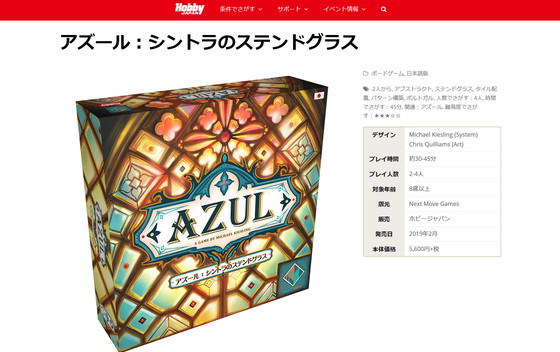
We reviewed what game "Azur" of the previous work is in the following article.
Actually played a severe game "Azur" requesting highly bargain between players against the beauty of appearance - GIGAZINE

◆ The content of the game "Azur: Sintra's Stained Glass" outer box looks something like this, stained glass is drawn on the background of the game title. The story of this game is that Manuel I who adorned the wall of the palace constructed in Evora with the beautiful pottery tile in the previous work called a glass craftworker to complete the stained glass of the Sintra palace chapel. Players must become glass craftsmen and complete the stained glass of the palace.
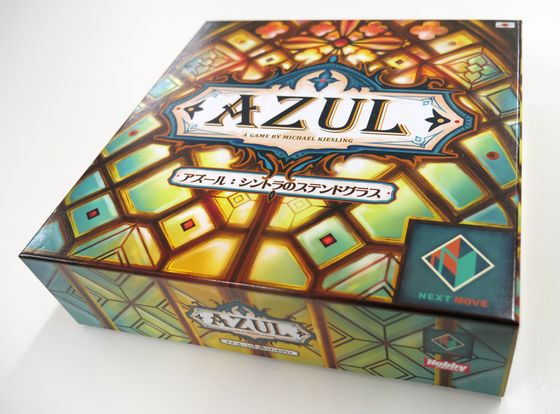
The target age is 8 years old and over, the number of players is 2 to 4 people, the play time is assumed to be 30 minutes to 45 minutes.
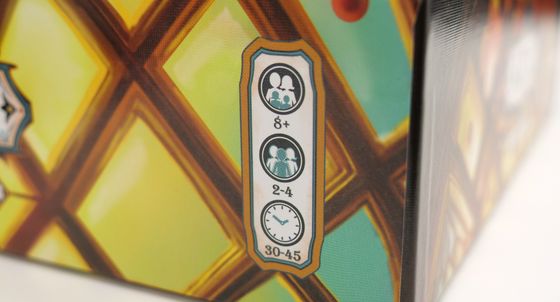
Contents are glass tower and cloth bag, scoring board ......

1 palace board × 4 colors, 8 design sheets × 4 colors, glass craftsmanship 1 × 4 colors, scoring markers 2 × 4 colors, start player marker, nine workshop exhibition boards, 20 stained glass tiles × 5 colors.

The cloth bag used to store stained glass tiles was purplish red in the current work, while the previous work was blue.

In the previous work, it was a setting called a tile on the wall of the palace, but in this work we will deal with a stained glass that adorns the palace window. All five stained glass shining brightly and clearly. Appearance looks like a drop or jewelry, so everyone who was in the place sighs as "Beautiful ... ...."

The glass tower looks something like this. It is a container used to put stained glass that is no longer needed, and it is designed like a tower stained with stained glass. The contents which were not in the previous work, the impact when put in the place is considerable.
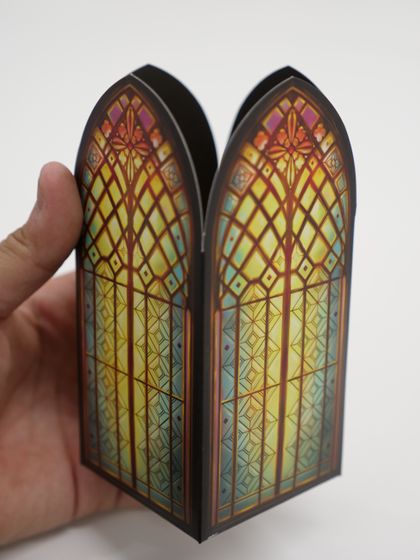
The workshop exhibition board where the stained glass is arranged looks like this. It is almost the same as the previous work ... ...

In this work, it is color-coded to put five colors of stained glass on the reverse side. The color of the stained glass is important in this game, but since it can be distinguished by the pattern and the position written on the workshop exhibition board, people with color vision abnormality can play together.
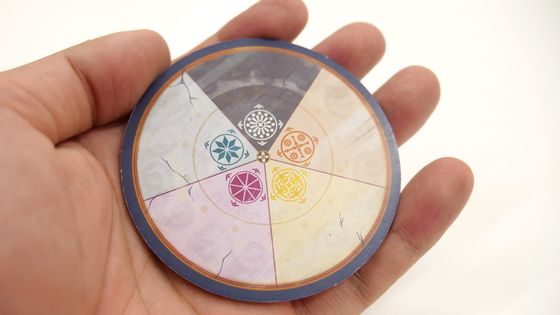
Four palace boards are prepared, and the upper part is jagged. "A side" and "side B" are prepared, and the score calculation is slightly different depending on the surface.

Color tiles of the same color as the stained glass are drawn on the graphic form. There is a notch in the mountain shape at the end of the graphic form ... ...
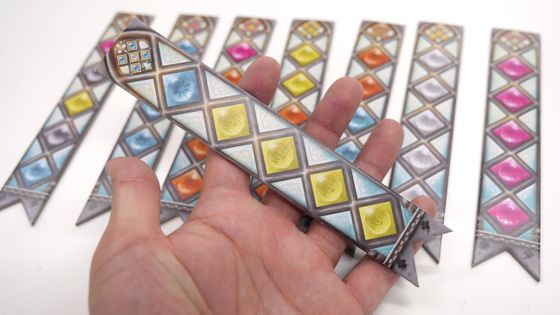
Combined with the palace board, it becomes a player board.
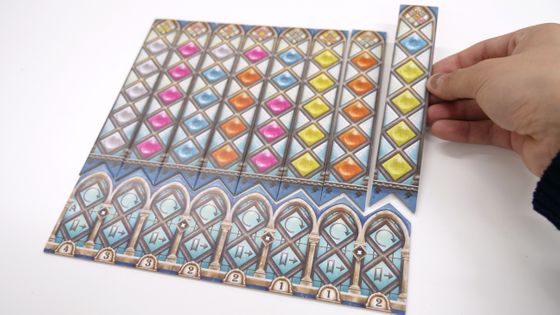
Although the score was shown on the individual player board in the previous work, since the scoring board is separately prepared in this work, it is easy for everyone to grasp the score of each player.
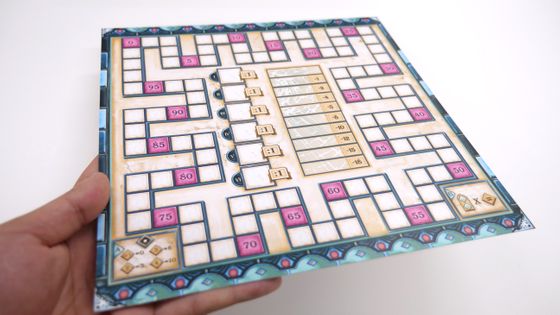
◆ Preparing the game <br> First of all, we decide the start player who will do the first turn. In the explanation, "The person who wiped the window the most recently was the start player", but all the editing members who were playing muttered "Window cleaning ......?" Twinkling with far eyes Nobody I decided not to speak, so I decided it with scissors this time. The start player receives the start player marker.
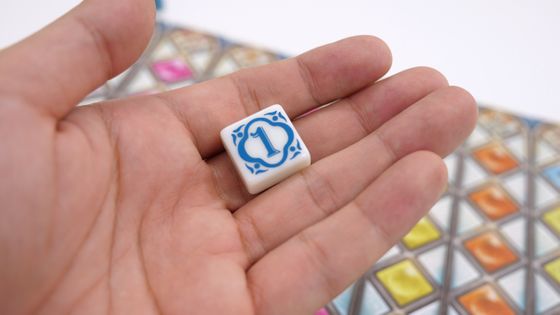
Place a player marker in the scoreboard's "0" position and in the center right penalty display area. Start players arrange five stained glasses from the bottom in the round display part on the center left of the scoring board. Place one stained glass further randomly drawn on top of 5 pieces.
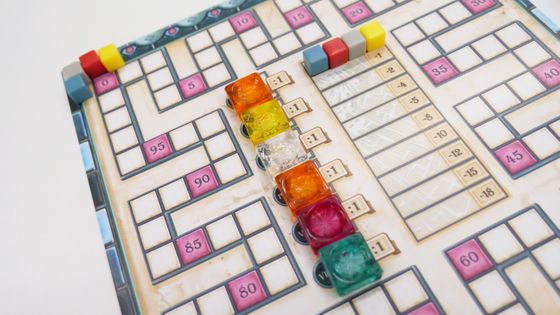
Each player randomly combines design papers on the palace board, prepares the player board, and arranges glass craftsmen's tops on the leftmost design vote.
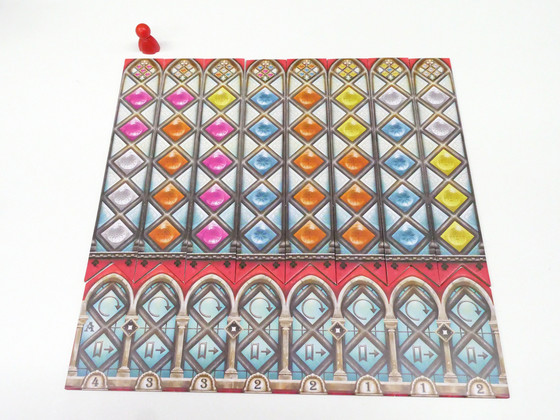
Workshop exhibition boards Nine rows are arranged in a row, preparing four stained glasses at random for each one.
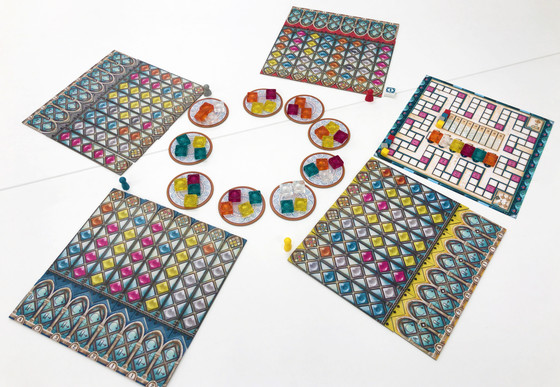
◆ How to play the game Start turning from the start player. The active player picks up only one color of stained glass from the exhibition board of the workshop, collects the tiles of the remaining color to the center of the battlefield.
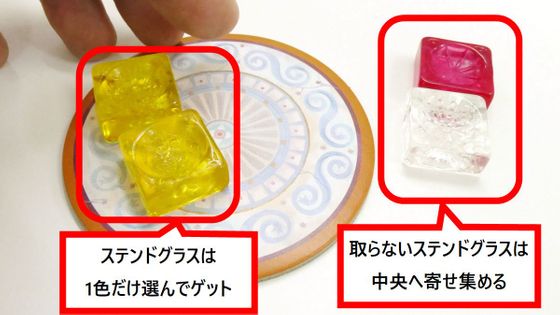
You can place the stained glass in the graphic form "Glass craftsmen 's row" or "Right from the column with glass craftsmanship". After placing the stained glass, move the glass craftsmen onto the placed design voucher. In other words, glass craftsmen will move to the right as the game progresses.
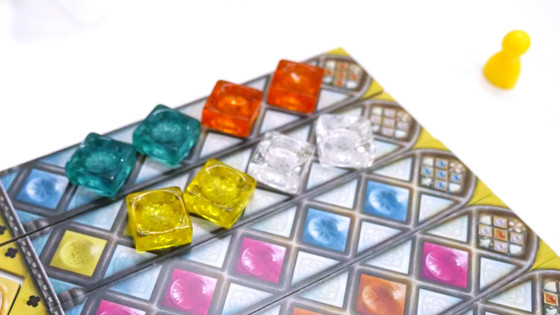
For example, in the image below, the player is picking up a red stained glass, but the graphic design on the right of the column where the glass craftsmen are located does not have a red stained glass mass, so you can not put it.
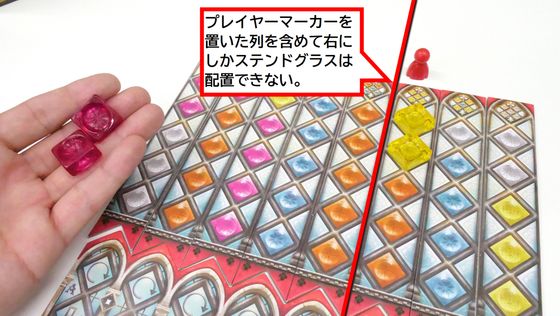
If you want to place it on the left, you can move the glass craftsmen to the leftmost column beforehand at your turn. However, you can not get a stained glass if you move a piece of glass craftsman. Therefore, it can be said that it is difficult to arrange it more like the graphic on the left column.
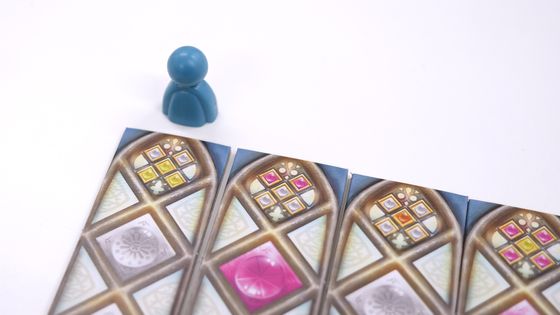
Once five tiles can be placed on the design voucher, the stained glass is completed. Choose one out of the five stained glasses ......
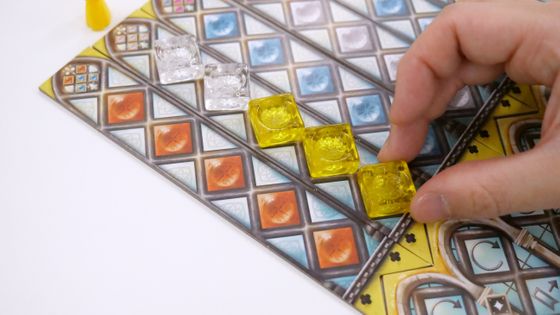
Place it in the same row frame with the palace board.
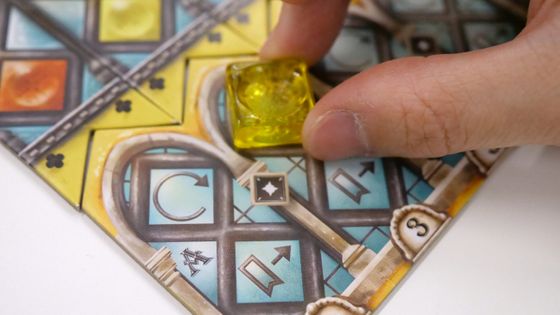
The remaining four will be "disposed of" in the glass tower.
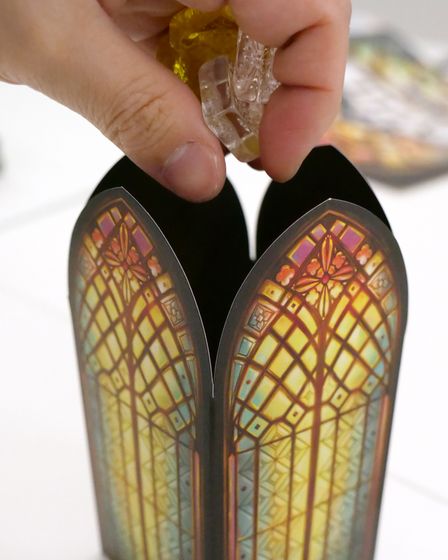
There are front and back sides of the design voucher, and use it once it is done.
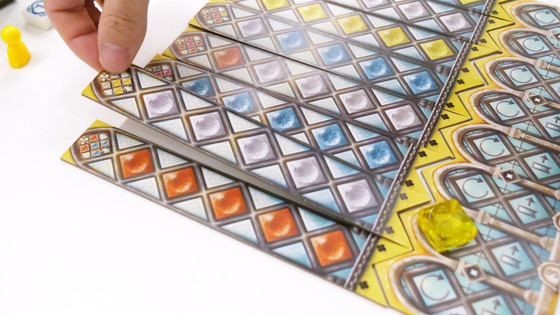
In addition, once you arrange the same design voucher once, remove that design voucher.

As a result, as the game progresses, the player board will become more and more missing teeth.
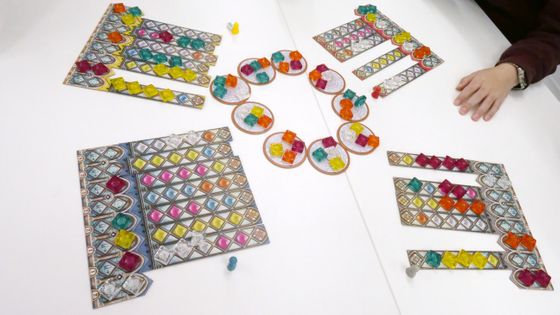
The purpose of this game is to gather stained glasses, place them on the player board according to the design voucher, complete the graphic form and score points. Every time a player has five stained glasses according to the design voucher, you can get the total of the following three points as scores.
· Numbers of the palace boards in the row with the stained glasses · Total of the numbers of the columns arranged on the palace board at the right of the glass craftsmen frame · Bonus points by the round display tile
For example, in the case of the following images, "Number of the palace board of the row with the stained glasses" is 2 , "Total number of rows where one or more are placed on the palace board, which is on the right of the glass craftsmen frame" is 2 + 1 + 2 = 5, and because the orange color at the top of the round display tiles are included two in design form was completed, you can get the 2 + 5 + 2 = 9 points.
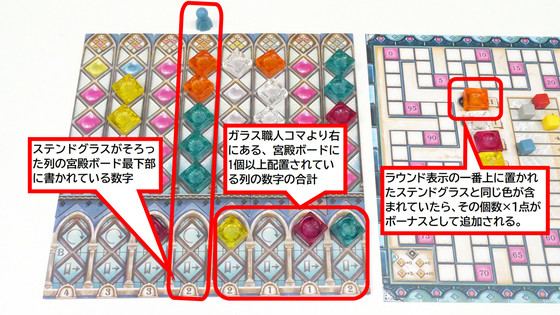
Completing the right design note and completing the left drawing table is important for greatly increasing the score. However, the glass craftsmen can move only to the right, and in order to arrange the design drawing on the left it is necessary to return the glass craftsmans once to the left end, so read the number of turns and see the timing in order to align the left We need to measure it. Where the width of the player's strategy is born in the place to think about in what order to complete the design voucher, the big point of this game.
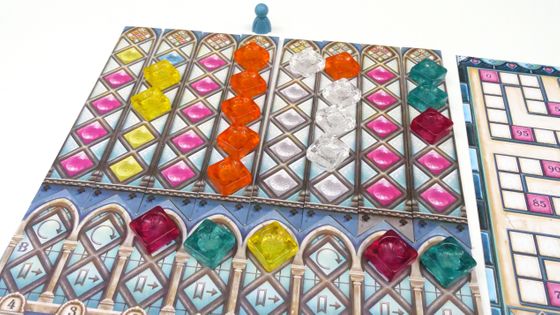
There is a score display part like Sugoroku on the score board, and we will add the score by moving the player marker.
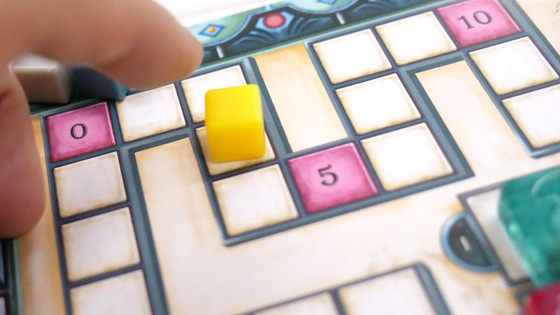
Stained glass can be gotten not only from the top of the exhibition board but also from the center of the place where leftovers are gathered ... ...

The player who hands the leftover at the very beginning receives a penalty, so shift the player marker placed on the penalty display part of the scoring board one down.
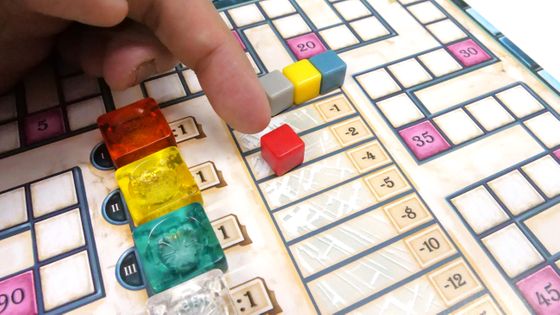
Collected leftovers may be obviously biased in color. For example, in the scenes below, there are 7 yellow stained glasses in the center.

The red player who wanted to match the design voucher of 5 yellow pieces got seven from the center regardless of the required amount. While arranging five pieces at a stretch, the design voucher was completed, but two more had been left.

"Because I need an extra stained glass because it is unnecessary", it will be disposed of in the glass tower.
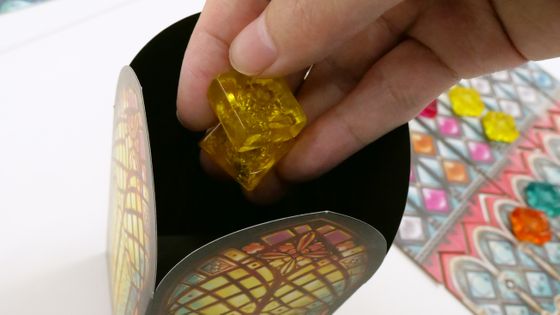
By "I have broken an important stained glass given by the King", I move the player markers in the penalty display part down by the number of divided pieces.
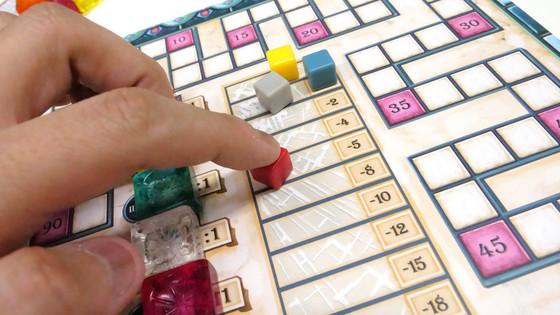
When all the stained glasses in the round display part are gone, the game is over. "It took 30 minutes to 45 minutes to play time", but it took about 1 hour and 15 minutes to play while actually knowing the rules with 4 people.
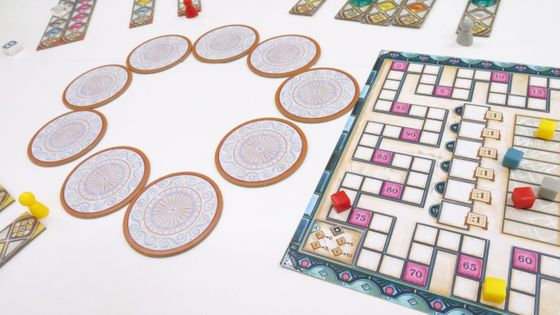
In the calculation of the final score, first add " one point for every 3 pieces of glass pieces remaining in the graphic form " to the score added up to now, and add "Bonus point for each face of the palace board". Calculation will change depending on whether the bonus points for each side of the palace board are A side or B side. For example, in the case of the A side, calculate by how many glasses are placed for each of the four window frames with feeling like the image below. 10 points if there are 4, 6 points if 3 pieces, 3 points if 2 pieces, 0 point if it is 1 piece or less.
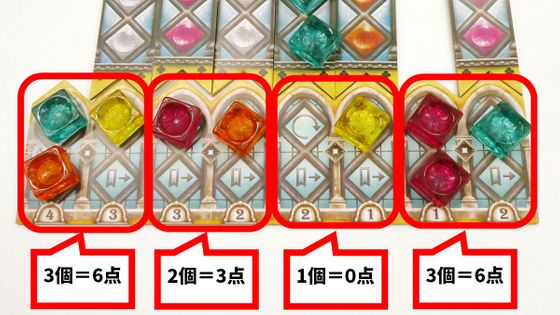
The final score is determined, reflecting the penalty points. The highest player will be victorious.
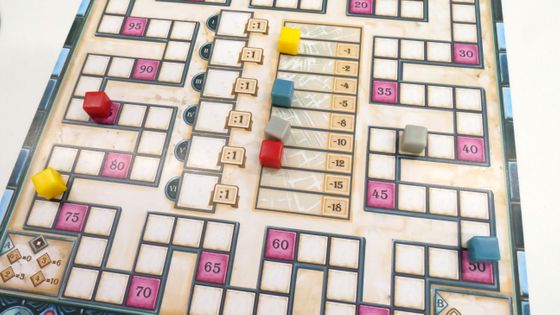
The stained glass of the player who got the most points and got first place is like this. Although a lot of stained glasses are placed and it is very beautiful, "The fourth row from the right was supposed to have the same color of the upper and lower colors, this lacks a strange rhinoceros," which was a craftsman's harsh self-evaluation.
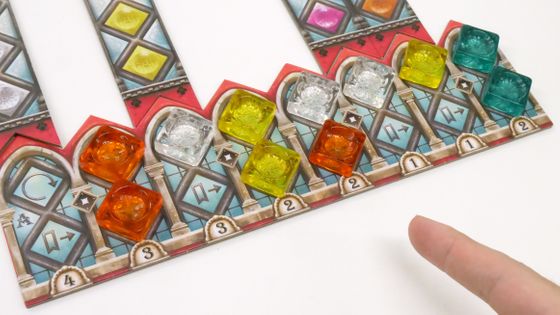
The dishes arranged in the center will change according to the number of players. In the following cases, we played with two people, the number of dishes is five. As the number of players with two players is small, you will be able to grasp the situation of the opponent's movements and the situation more firmly than playing with 4 players.
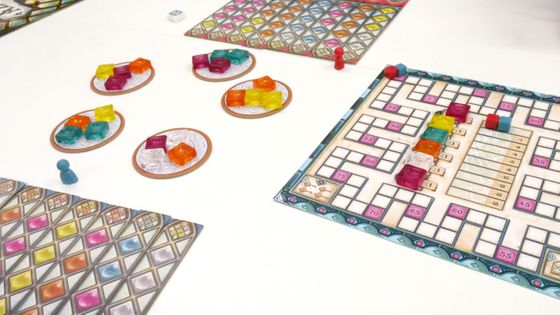
When I actually played, I felt it was a game with a high degree of completeness at the time of the previous work, with more innovative game nature and sophisticated visuals. Although the rules and the foundation of the system that "get tiles on the exhibition cards on the workshop" and "push the things gathered at the center of the battlefield" are the same, as a game it is almost like another game Impression that is becoming something. Especially, the strategy of the game increased with the restriction added to the columns that can be placed by the glass craftsmen coma, and it was content that reads several hands ahead of the previous work.
Although the score calculation is much more complicated than the previous work, the degree of difficulty of the game is even higher compared to the previous work, but since the rule itself can be understood immediately after playing once, the beginner But it is content that can be enjoyed. Rather than playing with four people while you are not used to playing games, first of all let's play slowly with 2 to 3 players, so it's recommended because you understand the rules.
"Azur: Sintra's stained glass" can be purchased at 52.80 yen at Amazon.co.jp.
Amazon | Azur: Sintra's stained glass Japanese version | board game | toys

Related Posts:






